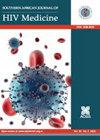坦桑尼亚达累斯萨拉姆的孤儿坚持抗逆转录病毒联合治疗
IF 1.6
4区 医学
Q4 INFECTIOUS DISEASES
引用次数: 8
摘要
背景HIV感染儿童坚持联合抗逆转录病毒疗法(cART)往往因各种因素而变得复杂,包括药物配方、给药频率、药物毒性、年龄和发育阶段、儿童和照顾者的心理社会和行为特征,此外,作为孤儿也可能使其复杂化。目的本研究旨在确定坦桑尼亚达累斯萨拉姆护理和治疗中心(CTCs)的HIV感染孤儿对cART依从性的影响因素及其程度。方法进行一项横断面研究,评估2-14岁HIV阳性孤儿接受基于奈韦拉平(NVP)的cART至少6个月的依从性。通过对感染艾滋病毒的孤儿的主要照顾者进行问卷调查、医疗档案审查以及NVP血浆浓度和CD4计数的实验室测量来收集数据。根据护理人员的自我报告、就诊的一致性和NVP血浆浓度来确定对cART的依从性。结果在216名登记的孤儿中,根据照顾者的自我报告、就诊情况和NVP血浆水平,对cART的依从性分别为79.6%、82.9%和72.2%。免疫结果差、就诊率低的儿童NVP浓度显著降低(<3µg/mL)(p<0.05),这是由照顾者自我报告的依从性(p=0.06)所提示的。照顾者发现的依从性挑战包括经济限制(87.5%),在诊所等待时间过长(75.5%的人在诊所待了2小时以上),护理人员对艾滋病毒的了解程度较低。结论根据不同的评估方法,大量HIV感染孤儿对cART的依从性较差,差异在17%至28%之间。护理人员对艾滋病毒/艾滋病的了解不足、漫长的诊所等待时间和健忘被确定为这些孤儿坚持cART的障碍。本文章由计算机程序翻译,如有差异,请以英文原文为准。
Adherence to combination antiretroviral therapy among orphaned children in Dar es Salaam, Tanzania
Background Adherence to combination antiretroviral therapy (cART) among HIV-infected children is often complicated by various factors including medication formulation, dosing frequency, drug toxicities, age and developmental stage, psychosocial and behavioural characteristics of both children and caregivers and can additionally be complicated by being an orphan. Objectives This study was aimed at determining the factors and the extent of their influence on cART adherence among HIV-infected orphaned children attending Care and Treatment Centres (CTCs) in Dar es Salaam, Tanzania. Methods A cross-sectional study was performed, which assessed adherence in HIV-positive orphaned children aged 2–14 years receiving nevirapine (NVP) based cART for at least 6 months. Data was collected using questionnaires administered to primary caregivers of HIV-infected orphaned children, the review of medical files, and the laboratory measurement of NVP plasma concentrations and CD4 counts. Adherence to cART was determined based on caregivers’ self-report, consistency of clinic attendance and NVP plasma concentrations. Results Among the 216 enrolled orphaned children, adherence to cART was found to be 79.6%, 82.9% and 72.2% respectively based on caregivers’ self-report, clinic attendance and NVP plasma levels. Significant reductions in NVP concentrations (< 3 µg/mL) were seen among children with poor immunological outcomes, poor clinic attendance (p < 0.05) and were suggested by caregivers’ self-reported adherence (p = 0.06). Adherence challenges identified by caregivers included financial constraints (87.5%), lengthy waiting times at clinics (75.5% spent > 2 h at the clinic) and low HIV knowledge among caregivers. Conclusion Significant numbers of HIV-infected orphans have poor adherence to cART ranging between 17% and 28% based on different assessment methods. Inadequate caregiver knowledge of HIV/AIDS, long clinic waiting times and forgetfulness were identified as barriers to cART adherence in these orphans.
求助全文
通过发布文献求助,成功后即可免费获取论文全文。
去求助
来源期刊
CiteScore
2.80
自引率
11.80%
发文量
41
审稿时长
>12 weeks
期刊介绍:
The Southern African Journal of HIV Medicine is focused on HIV/AIDS treatment, prevention and related topics relevant to clinical and public health practice. The purpose of the journal is to disseminate original research results and to support high-level learning related to HIV Medicine. It publishes original research articles, editorials, case reports/case series, reviews of state-of-the-art clinical practice, and correspondence.

 求助内容:
求助内容: 应助结果提醒方式:
应助结果提醒方式:


